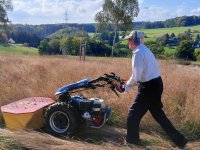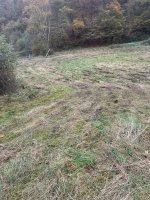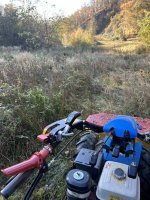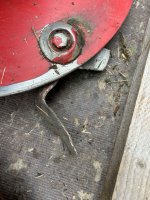Hi

I would like to share the experience that I have gathered so far with my Zanon ZRF 1000 drum mower, and also show photos from some of the jobs that I have completed with it.
Until I got my drum mower, I have used a 120 cm (47’’) sickle bar mower borrowed from a friend, so that is what I can best compare the drum mower to.
A sickle bar mower is basically a row of scissors placed close next to one another, and when proper adjusted and maintained, it provides a clean cut at the base of the material. It is also the least power-hungry mower available, but it is also the most sensitive to barbed wire, metal fence posts and the likes, that might easily damage the blades.
As all rotary mowers, a drum mower is very power-hungry indeed, and as explained in my original post, it is important to run the engine at full (or at least close to full) open throttle and at high engine speed, in order to have maximum engine power available. High engine speed is also important in order to keep a high disc speed, and even small drops in engine speed should be avoided by changing to a lower gear and/or to a smaller cut if possible.
When mowing the first round of any plot, I always drive in 1st gear. This allows me more time to react should I see an obstruction for instance, and it also put less load on the engine and powertrain, as the first cut has to be made with the full cutting width. If the material is not too dense, I try to make subsequent rounds in 2nd gear, as it is more than twice as fast as 1st gear. If the engine is struggling, I might reduce the cutting width, and still maintain 2nd gear. In dense grass that is often not enough, and I have to settle for 1st gear and a full cut at the much reduced speed.
My drum mower has a cutting width of 100 cm (40’’), and on the Zanon homepage, they recommend a tractor with 14-18 hp to power it:
https://api.zanon.it/assets/product-datasheets/zrf.pdf
I would love to have that kind of power available, but the Honda GX 390 engine on my BCS 740 sadly produces 11.7 hp only. According to the Zanon data sheet, the 80 cm (32’’) drum mower requires 10-14 hp, which fits perfectly to the GX 390 engine.
In real life, the power needed to run the mower depends heavily on the density of the material to be cut of course, and based on my experience, the numbers in Zanons data sheet will cater for even the toughest conditions.
If at all possible, I try to run all my 3 mowers in 2nd gear when working, as that gives by far the best performance. With the 6.5x12x23’’ wheels, and running the engine at rated speed (3600 rpm), the tractor will drive at a pleasant 3.54 km/h (2.20 mph). With the 100 cm mower and 10 cm (4’’) overlap, that will allow a maximum performance of up to: 0.9 x 3.54 x 1000 = 3,186 m² (34,294 ft²) an hour.
In 1st gear the tractor will only drive at a modest 1.53 km/h (0.95 mph), allowing a maximum performance of up to: 0.9 x 1.53 x 1000 = 1,377 m² (14,822 ft²) an hour only.
Here is a photo from a job in the autumn of 2022:
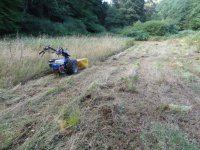
The summer of 2022 was very dry in my area, and the grass was therefore so sparse, that I could mow in 2nd gear with only my normal 10 cm (4’’) overlap.
On another job that autumn I was mowing an orchard where the grass was slightly more dense, but with around 20 cm (8’’) overlap, I could still mow in 2nd gear:
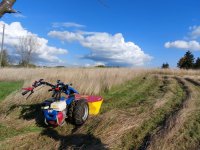
A few days later on my own meadow things got tougher, with up to 2 m (6½’) tall material, mainly stinging nettles, thistle and blackberries. Here I had to downshift to 1st gear:
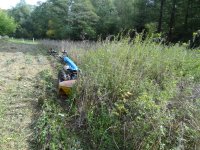
In the summer of 2023 we had a lot of rain, and as I arrived at the above mentioned orchard this time, it was obvious that this was going to be a 1st gear job:
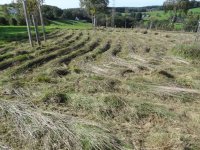
Clearly the windrows are much more dense this time, but with a little extra overlap we made it.
All of the above hopefully shows, that depending on the density of the crop to be mowed, the 100 cm (40’’) drum mower might be the proper size for an almost 12 hp engine. It is important though, that one can mow mostly in 2nd gear in order to get a good performance.
If you have mostly very dense grass of the sort that most farmers prefer, the smaller 80 cm (32’’) or even 70 cm (28’’) models might be the better choice. With the smaller models, one can probably mow in 2nd gear in most crops, and easily get more done compared to a wider mower working in 1st gear. On the other hand, one can’t benefit much when the crop is sparse, as you are already in 2nd gear.
One advantage of the smaller models, is that they are lighter. The 100 cm (40’’) model weights 98 kg (216 lbs), which makes it a handful for a „skinny“ old man to lift off the ground pressing the handlebars. Saving 13 kg (29 lbs) or even 26 kg (57 lbs) using the smaller models might come in handy.
Talking about weight, any rotary mower is heavier than even a wider sickle bar mower, and that might have an impact on the mowing quality.
My meadow is 6200 m² (1.5 acre), but most of the plots that I mow are much smaller than that. As we rake the cut material by hand - and also remove it from the field by hand, one really notice wether the grass has been cut clean at the base, or if small spots have been left uncut letting the rake get stucket.
I have noticed - and many costumers tells me so as well, that raking after the drum mower is way easier than after the sickle bar mower I used to use. I think this is due to the fact that the drum mower follows the ground surface much more accurate, whereas the sickle bar mower - due to its much lower weight - tends to „jolt“ a little when mowing on uneven terrain, leaving small „wads“ uncut.
Best regards
Jens









